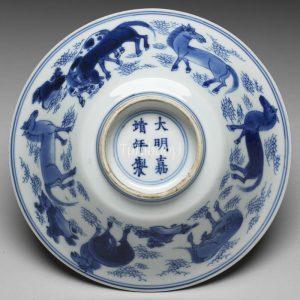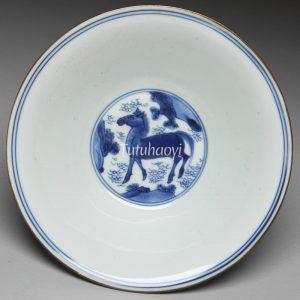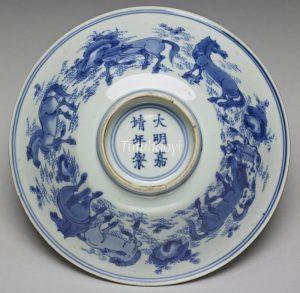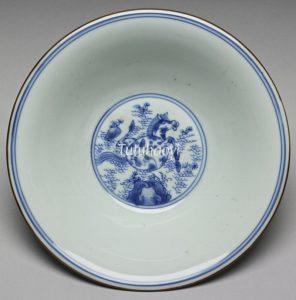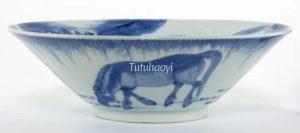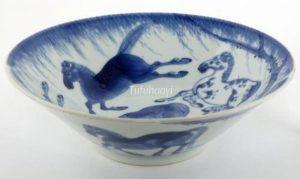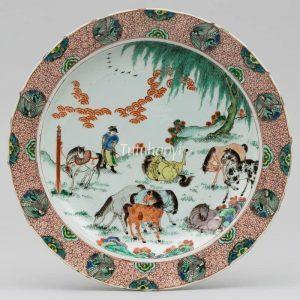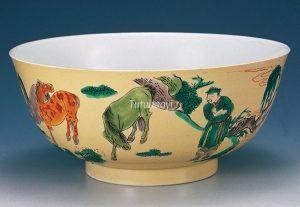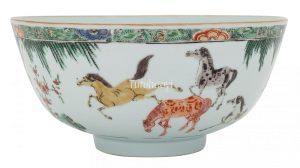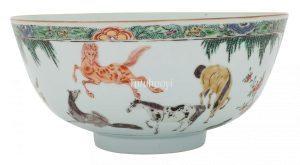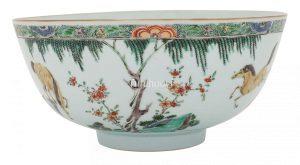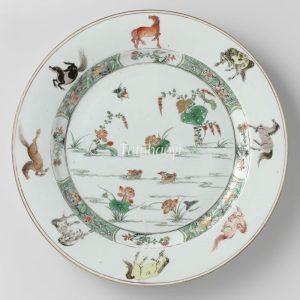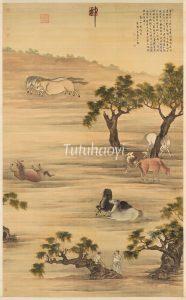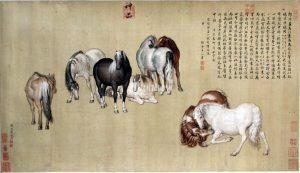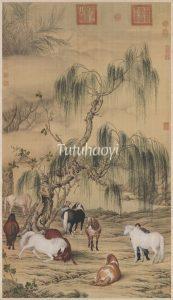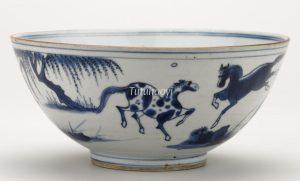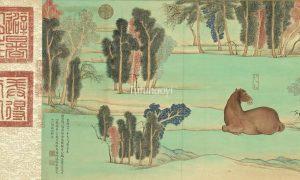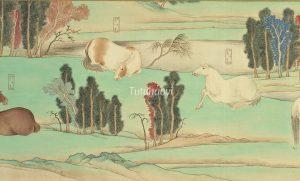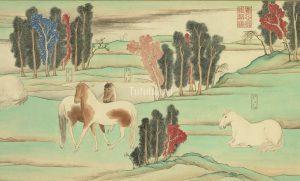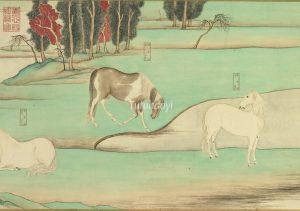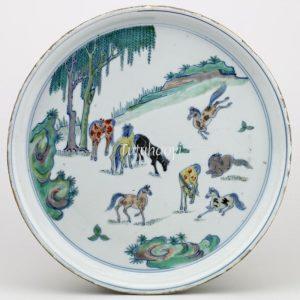The Eight Horses
八骏图
© Tutuhaoyi.com owns the copyright of the description content for the images attached. Quoting all or part of the description content on this page is permitted ONLY IF ‘Tutuhaoyi.com’ is clearly acknowledged anywhere your quote is produced unless stated otherwise. (本页描述内容版权归Tutuhaoyi.com所有,转发或引用需注明 “Tutuhaoyi.com”, 侵权必究, 已注开源信息的条目除外。)
The ‘Eight Horses’ (Ba Jun Tu 八骏图) is a classic motif in Chinese art, especially prominent in ancient paintings. Its origins are closely tied to the legendary journeys of King Mu of the Zhou Dynasty (周穆王), who reigned around the 10th century BCE. According to The Tale of King Mu (Mu Tianzi Zhuan 穆天子传), an ancient text unearthed from Warring States period tombs, King Mu of Zhou, the fifth ruler of the Western Zhou dynasty (c. 1046–771 BCE), was a monarch with a passion for exploration. He is said to have travelled vast distances, covering ninety thousand li, drawn by a chariot pulled by eight divine steeds. His legendary westward expedition led him to Mount Kunlun, where he visited the mythical palace of the Yellow Emperor and held a banquet at the Jade Pool, exchanging songs with the Queen Mother of the West.
The names of these eight magnificent horses vary across historical texts. In The Tale of King Mu, they are listed as Huáliú (骅骝), Lu’er (騄耳), Chìjì (赤骥), Báixī (白羲), Qúhuáng (渠黄), Yúlún (逾轮), Dàolí (盗骊), and Shānzǐ (山子). Each name reflects qualities of strength, speed, and divine prowess. In contrast, the Records of Gleanings (Shiyi Ji 拾遗记) by Wang Jia of the Eastern Jin dynasty offers a more fantastical interpretation, naming the horses: Juédì (绝地), Fānyǔ (翻羽), Bēnxiāo (奔霄), Yuèyǐng (越影), Yúhuī (逾晖), Chāoguāng (超光), Téngwù (腾雾), and Xiéyì (挟翼). These names evoke imagery of unparalleled speed, radiant brilliance, and the ability to soar beyond the ordinary, symbolising supernatural abilities.
Throughout history, renowned literati such as Bai Juyi, Liu Zongyuan, Yuan Zhen, and Li Guan composed verses and articles praising the beauty and mythical attributes of the eight steeds. Their poems not only celebrated the horses’ majestic qualities but also extolled the grandeur and far-reaching influence of kingship, reflecting the ideals of dominion, ambition, and the pursuit of power in ancient China.
The motif of the Eight Horses has endured through centuries, appearing in paintings, ceramics, and decorative arts, embodying both artistic elegance and profound cultural symbolism.
Literature research by Rachel Ma
Fig 1-2: porcelain bowl with underglaze blue decoration, Jiajing period (1522–66), Ming dynasty, courtesy of the National Palace Museum, Taipei
Fig 3-4: porcelain bowl with underglaze blue decoration, Jiajing period (1522–66), Ming dynasty, courtesy of the National Palace Museum, Taipei
Fig 5-6: porcelain bowl (partially cut) with underglaze blue decoration, 1630–1660, courtesy of Musée Ariana, Geneva, Switzerland, photo: Angelo Lui
Fig 7: famille verte porcelain dish, Kangxi period (1662–1722), Qing dynasty, courtesy of The Dresden Porcelain Collection, State Art Collections of Dresden, Germany, photo: Adrian Sauer
Fig 8: porcelain bowl with overglaze enamelled decoration, Kangxi period (1662–1722), Qing dynasty, courtesy of the Suzhou Museum, Jiangsu Province, China
Fig 9-11: porcelain bowl with overglaze enamelled decoration, Kangxi period (1662–1722), Qing dynasty, courtesy of the Jie Rui Tang Collection, archived
Fig 12: porcelain dish with overglaze enamelled decoration, c.1720 – c.1730, courtesy of the Rijksmuseum, Amsterdam
Fig 13: Eight Horses八骏图, hanging scroll, ink and colour on silk, Gao Qipei 高其佩 (1660–1734), courtesy of the National Palace Museum, Taipei
Fig 14: Eight Steeds 八骏图, hand scroll, ink and colour on silk, Giuseppe Castiglione (1688–1766), Yongzheng period (1723–35), Qing dynasty, courtesy of Jiangxi Provincial Museum, China
Fig 15: Eight Steeds 八骏图, hand scroll, ink and colour on silk, Giuseppe Castiglione (1688–1766), possibly Yongzheng period (1723–35), Qing dynasty, courtesy of the Palace Museum, Beijing
Fig 16: porcelain bowl with underglaze blue decoration, 1700–1750, courtesy of the Trustees of the British Museum
Fig 17-20: Eight Praised Stallions 八骏图, hand scroll, ink and colour on silk, Jia Quan 贾全, 1776, Qing dynasty, courtesy of the National Palace Museum, Taipei
Fig 21: porcelain tray with underglaze blue and overglaze enamelled decoration, 18th century, courtesy of the Trustees of the British Museum
